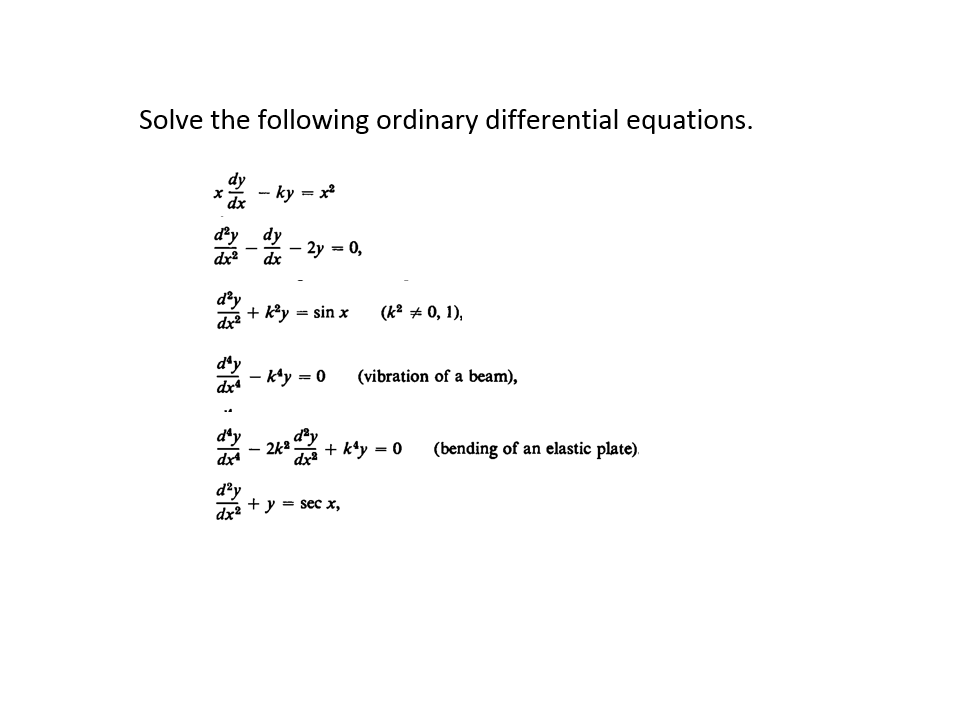QQuestionAnatomy and Physiology
QuestionAnatomy and Physiology
Solve the following ordinary differential equations.
\begin{aligned}
& x \frac{d y}{d x}-k y=x^{2} \\
& \frac{d^{2} y}{d x^{2}}-\frac{d y}{d x}- 2 y= 0 \\
& \frac{d^{2} y}{d x^{2}}+k^{2} y=\sin x \quad\left(k^{2} \neq 0,1\right) \\
& \frac{d^{4} y}{d x^{4}}-k^{4} y= 0 \quad \text { (vibration of a beam) } \\
& \text {.. } \\
& \frac{d^{4} y}{d x^{4}}- 2 k^{2} \frac{d^{2} y}{d x^{2}}+k^{4} y= 0 \quad \text { (bending of an elastic plate) } \\
& \frac{d^{2} y}{d x^{2}}+y=\sec x
\end{aligned}
Attachments

6 months agoReport content
Answer
Full Solution Locked
Sign in to view the complete step-by-step solution and unlock all study resources.
Step 1: First-order linear ordinary differential equation
x^{-k} \frac{dy}{dx} - k x^{-k-1} y = x^{-k} x
The first equation is a first-order linear ordinary differential equation. We can write it in the standard form as: To solve this equation, we need to find an integrating factor, which is given by: For our equation, the integrating factor is: Now, we multiply both sides of the equation by the integrating factor:
Step 2: Find the general solution
y(x) = x \left( \int x^{-1} dx + C \right) = x (\ln |x| + C)
Final Answer
The general solution is given by: y(x) = y_h(x) + y_p(x) = c_1 \cos (kx) + c_2 \sin (kx) + \frac{1}{1 +k^2} \sin x where c_1 and c_2 are arbitrary constants. Step 7: Fourth-order homogeneous linear ordinary differential equation with constant coefficients The fourth equation is a fourth-order homogeneous linear ordinary differential equation with constant coefficients. We can write it in the standard form as: \frac{d^4 y}{dx^4} + a \frac{d^3 y}{dx^3} + b \frac{d^2 y}{dx^2} + c \frac{dy}{dx} + d y = 0 where a = 0, b = 0, c = 0, and d = -k^4. To solve this equation, we first find the roots of the characteristic equation: r^4 + a r^3 + b r^2 + c r + d = 0 The characteristic equation reduces to: r^4 = k^4 The roots are r = k, r = -k, r = i k, and r = -i k. Thus, the general solution is given by: y(x) = c_1 \cos (kx) + c_2 \sin (kx) + c_3 e^{kx} + c_4 e^{-kx} where c_1, c_2, c_3, and c_4 are arbitrary constants. Step 8: Bi-fourth-order homogeneous linear ordinary differential equation with constant coefficients The fifth equation is a bi-fourth-order homogeneous linear ordinary differential equation with constant coefficients. We can write it in the standard form as: \frac{d^4 y}{dx^4} + a \frac{d^3 y}{dx^3} + b \frac{d^2 y}{dx^2} + c \frac{dy}{dx} + d y = 0 where a = 0, b = - 2 k^2, c = 0, and d = k^4. To solve this equation, we first find the roots of the characteristic equation: r^4 + a r^3 + b r^2 + c r + d = 0 The characteristic equation reduces to: r^4 - 2 k^2 r^2 + k^4 = 0 This is a biquadratic equation, which can be factored as: (r^2 - k^2)^2 = 0 The roots are r = k, r = -k, r = i k, and r = -i k. Thus, the general solution is given by: y(x) = c_1 \cos (kx) + c_2 \sin (kx) + c_3 e^{kx} + c_4 e^{-kx} where c_1, c_2, c_3, and c_4 are arbitrary constants. Step 9: Second-order non-homogeneous linear ordinary differential equation The last equation is a second-order non-homogeneous linear ordinary differential equation. We can write it in the standard form as: \frac{d^2 y}{dx^2} + a \frac{dy}{dx} + by = f(x) where a = 0, b = 1, and f(x) = \sec x. To solve this equation, we first find the roots of the characteristic equation: r^2 + a r + b = 0 The roots are r = \pm i. Thus, the complementary solution is given by: y_c(x) = c_1 \cos x + c_2 \sin x Now, we need to find a particular solution. We can use the method of variation of parameters. The Wronskian of the complementary solution is: W(x) = \begin{vmatrix} \cos x & \sin x \ -\sin x & \cos x \end{vmatrix} = 1 Thus, the coefficients u_1 and u_2 satisfy: \frac{du_1}{dx} = -u_2 f(x) = -u_2 \sec x \frac{du_2}{dx} = u_1 f(x) = u_1 \sec x Integrating both sides, we get: u_1(x) = \int -u_2 \sec x dx u_2(x) = \int u_1 \sec x dx We can find u_1 and u_2 by solving this system of equations. However, this process is quite lengthy and involves integration by parts. y(x) = y_c(x) + y_p(x) = c_1 \cos x + c_2 \sin x - \tan x \ln |\cos x + \sin x| + C where c_1 and c_2 are arbitrary constants, and C is the constant of integration from finding u_1 and u_2.
Need Help with Homework?
Stuck on a difficult problem? We've got you covered:
- Post your question or upload an image
- Get instant step-by-step solutions
- Learn from our AI and community of students